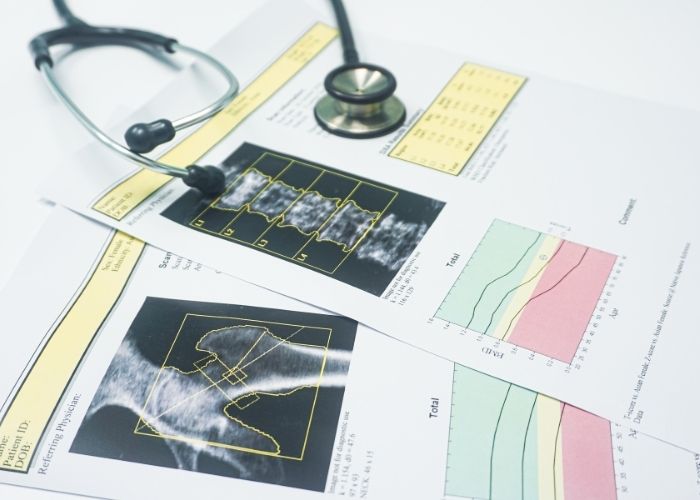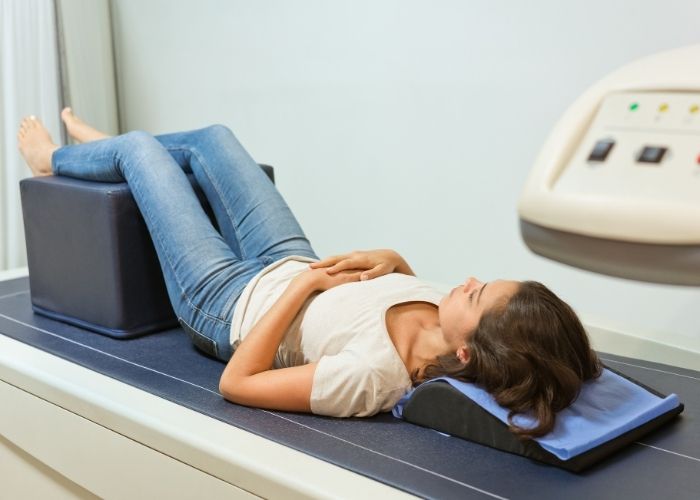
A bone density scan is a simple, painless test that plays a key role in understanding the health and strength of your bones—especially after menopause or if you have other risk factors.
In this post, we’ll explain how a bone density test works, who should consider getting one, and how to interpret your results. You’ll also learn why these scans are important for early intervention and ongoing bone health.
What is a bone density scan and how does it work? 🔍
A bone density scan (DEXA or dual energy x-ray absorptiometry) uses low-dose x-ray beams to assess the strength of your bones. Assessing bone density helps identify your risk of fractures or osteoporosis.
Measurements are typically taken at areas more prone to fracture, such as the hip, pelvis, lumbar spine, and sometimes the wrist.
Who should have a bone density scan? 🧬
Medical guidelines recommend a DEXA scan for:
- Those older than 65 (or 70 for men)
- Anyone over 50 at higher risk for osteoporosis
(e.g. due to family history, early menopause, gastrointestinal disorders, autoimmune conditions or use of medications that affect bone health)
Due to the sharp drop in bone density associated with hormonal changes, many experts recommend a DEXA scan after menopause to establish a baseline.
What to expect during your scan 🛏️
The scan takes around 10–15 minutes. You’ll lie on your back on a padded table while a scanning arm passes over your body. It’s completely painless, quiet, and usually doesn’t require changing clothes (unless you’re wearing metal).
Importantly, results are usually sent directly to your doctor for review.

Understanding your scan results 📊
T-Score
This compares your bone density to a healthy 30-year-old of the same sex:
- 0 to -1 = Normal
- -1 to -2.5 = Osteopenia (low bone density)
- Below -2.5 = Osteoporosis
Z-Score
This compares your results to someone your same age and sex. It’s not used to diagnose osteoporosis but helps identify if your bone density is outside the normal range for your age.
- Above 0 = Above average
- Below 0 = Below average
- Below -2 = May suggest an underlying condition (secondary osteoporosis)
Why your bone density scan matters 💡
Your results help estimate fracture risk and guide decisions about treatment. For example, your healthcare provider may recommend:
- Supplements (such as calcium or vitamin D)
- Medications to reduce bone loss
- Lifestyle or dietary changes
- Resistance exercise (which we will discuss in depth in our next blog!)
Furthermore, bone density scans are valuable for monitoring treatment progress. If you’re on medication or following a targeted exercise program, repeat scans (usually every two years) can track changes. Whenever possible, use the same machine to ensure consistent results.
Is a Bone Density Scan Right for You? 🧠
If you’re unsure whether you need a bone density scan, speak with your GP or book an appointment with our team. We can help assess your risk, interpret results, and design an evidence-informed plan to support strong, healthy bones. 💪🏼
Contact Us ☎️
If you would like to book an appointment with one of our physiotherapists to discuss your results or work to create a plan to support your bone density health—we’d love to help. 📞 Call us on (03)88284761 or BOOK HERE to schedule your physiotherapy assessment.
